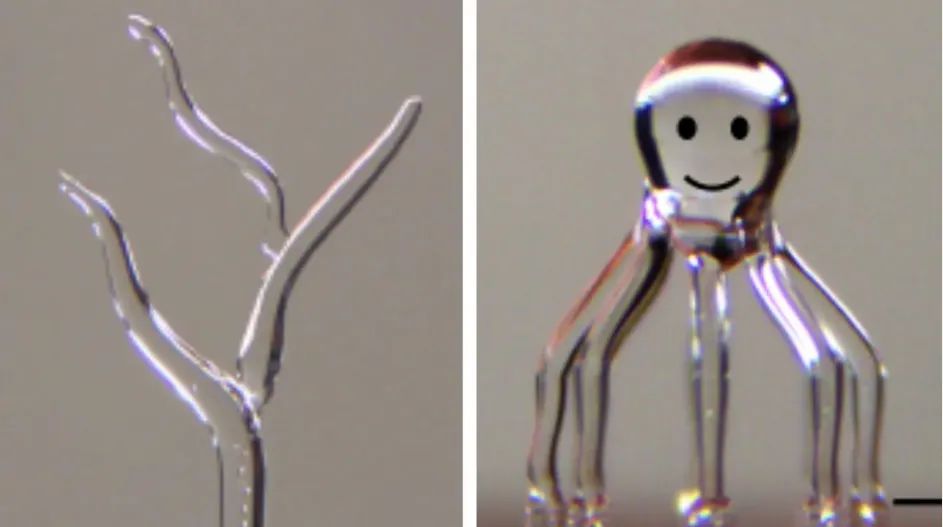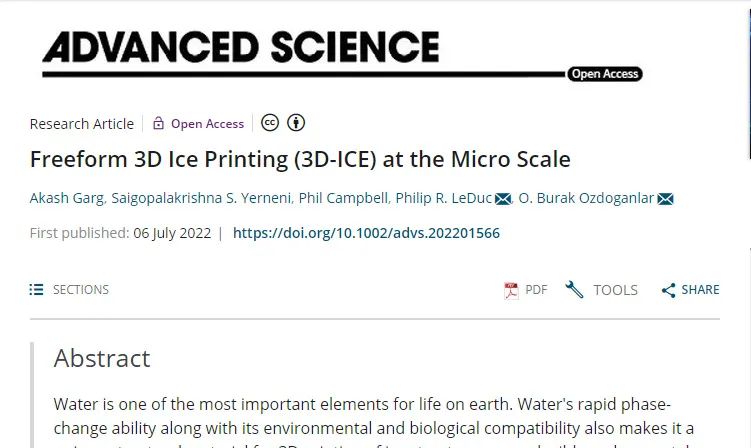
Ice 3D printing technology, can print any ice structure!!
Share
Ice 3D printing
On August 23, 2022, Antarctic Bear, the well-know 3D printing journalist, learned that researchers at Carnegie Mellon University (CMU) have developed a way to 3D print tiny ice structures. According to an article published on the university's official website, the high-speed, reproducible manufacturing method is relvolutionary in 3D printing technology in the future. The technology can be widely used in advanced manufacturing and biomedical engineering in the future.

△3D printed structure in ice
"By using our ice 3D printing process, we were able to create microscopic ice templates with smooth walls and smooth transition branches," said Dr Akash Garg, a PhD scholar in mechanical engineering at Carnegie Mellon University. "This technology could be used in the future to create miniature parts with well-defined internal voids."
Technology background
Garg and CMU Chemical engineering postdoctoral associate, Saigopalakrishna Yerneni, collaborated on this study.
Water is considered the best choice for bioengineering applications because it is the most abundant substance on the Earth's surface and a major component of all living organisms.The simple and rapid transformation of water into ice makes it a very environmentally friendly structural material.
"There is no more biocompatible natural material than water." Garg said.

△Freeform ICE printing (3D-ICE).A) Customized 3D printing system and its main components, including cooling system, movement table and piezoelectric nozzle.B) Piezoelectric inkjet nozzles are used to spray water droplets (diameter =50 microns) onto a cold built platform maintained at -35°C.The planar (X-Y) motion of the constructed platform is synchronized with the water droplet discharge to print the complex ice geometry
How does it works
Printed ice structures are used as "reverse molding" or ice templates are used as sacrificial geometry, where ice structures are immersed in cooled structural materials such as resin in liquid or gel form.
After the material has set or solidified, the water is removed. For this purpose, ice can be melted to drain water. Alternatively, ice can be sublimated by turning it into water vapor instead of liquid water. Because ice can sublimate easily, it can be easily removed after casting and curing the surrounding structural material.
A high-resolution 3D-printing system was used to deposit water droplets onto a temperature-controlled platform at minus 35 degrees Celsius to rapidly convert water into ice.
The new process can print branching geometry with smooth surfaces and smooth transitions by adjusting the spray frequency of the water droplets and synchronizing with the platform movement.

△Artical has been published on Advanced Science
Achievement
The researchers demonstrated this by printing a tree, a spiral around a pole, and even a 5-metre-tall octopus figurine out of ice. Due to the rapid phase transition of water and the strength of ice, therefore, 3D printing can achieve arbitrary ice structures without time-consuming layer-by-layer printing or supporting structures.
"We conducted experiments to determine the printing paths, movement speeds, and droplet frequencies required to fabricate light-skating structures with straight, slanted, branched, and layered geometries in a repeatable manner." Garg explained.
"This is an amazing achievement that will lead to exciting scientific advances." explains Burak Ozdoganlar, associate director of the CMU Engineering Research Accelerator, who oversaw the research.
He continued: "We believe this approach has great potential to revolutionize tissue engineering and other fields that require microstructures with complex channels, such as microfluidic and soft robotics."
The team claims that in just one year, the ice 3D process could be used for engineering applications, such as creating pneumatic channels for soft robots. However, the clinical application of tissue engineering will take much longer. In the future, this new process approach could also bring new opportunities for microfluidics, biomedical devices, flexible electronics and the arts.
About Fashion3d
Fashion3d was funded at 2018 at Australia Melbourne. We are mainly focused on 3D manufacturing and design. Our team can provide you with professional advise on your projects. And also supply the best 3D manufactoring tools to our customers.
